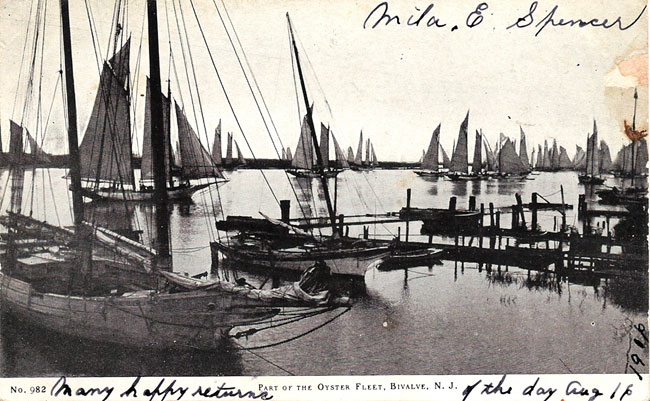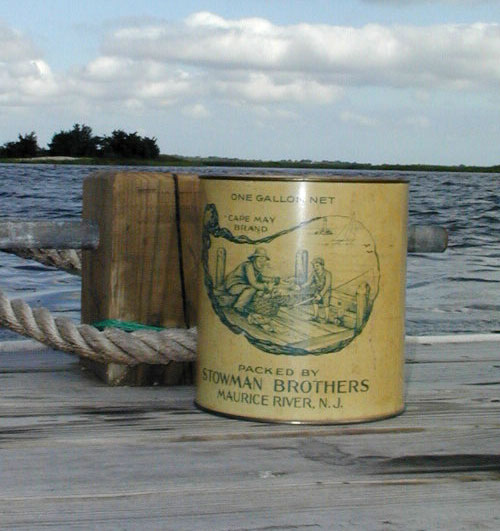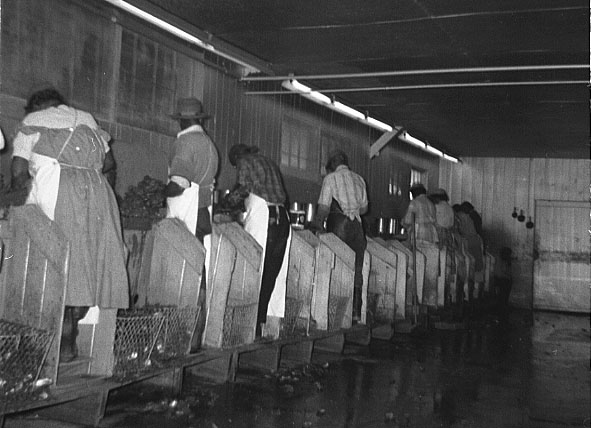The Maurice River Reaches Project
Shellpile Bivalve
Reach #45

In Bivalve, Thanksgiving was celebrated on a Sunday. Between 1860 and the early 1900's, the little Maurice River community in Commercial Township had become the "Oyster Capital of the World." But the calendar change was not a lofty whim. This was an industrious community that lived by the tides of the oyster. With the exception of Christmas, all holidays in Bivalve were celebrated on Sunday, because that's when Bivalve's oystermen were home.
In her book, Passing it On, local writer Rita Zorn Moonsammy captured folk traditions like these. Moonsammy gave a glimpse at how "the life of the town was paced by the industry."
The rhythms of the oyster industry took in the seasons for planting and the seasons for harvesting. On Sunday evenings, families said their good-byes, and on Friday evenings the locals gathered to see the fleet of oyster schooners return, with the sails billowing and their decks piled high.

Over the decades, modernized equipment, healthy competition and new government policies regarding the industry brought prosperity to the mouth of the Maurice River. An oyster parasite brought its demise.
Since the times of the Native Americans, and until 1957, when the oyster beds were decimated by the parasite, the town of Port Norris provided the labor force and the supporting businesses that enabled the growth of oyster-related facilities at Bivalve. The structures, the customs house, the blacksmith shop, the sailoft, the shucking and packing houses, and railroads and wharves were anchored by the thriving oyster industry.
Shellpile was the counterpart to Bivalve - a community that took root when the labor force, mostly African Americans from Delaware and Maryland, came to work in the oyster houses. The obvious landmark of this Maurice River reach were the piles of oyster shells that interrupted the flat spread of the river bank.

Another landmark, at the time when Bivalve was the "Oyster Capital of the World," were "the barracks," rows of dwellings that lined a few narrow stretches of road called Front, Back , Church and School Streets. The book, NJ: A Guide to its Present and Past (a 1939 Federal Writers project), described the "wooden barracks erected on stilts over the salt marshes. The shell roads to the mainland are renewed each year as the mud swallows the latest layer. From 500 to 1000 Negroes here live their own lives in their own way and present a united and rather hostile front to the rest of the world.” (see photos of oyster processing)

Today Bivalve is the site of the Bayshore Discovery Project, whose mission it is to preserve the history and lore of these oystering communities. Bivalve is also home base for the A.J. Meerwald, NJ's Official Tall Ship. Shellpile is now just a stop on a relatively new bike trail established along this historic southern portion of Cumberland County.
Local artist Pat Witt has sketched and painted the landscapes, the structures and the last of the vessels that echoed of this era of history along the Maurice River. "Everything I painted at Shellpile and Bivalve no longer exists," Pat lamented. Still, she returns, for the annual Oyster Suppers - and for the "absolutely colossal" sunsets that illuminate the natural beauty on the river's edge.
Radio Shorts To learn more about the Maurice River, check out CU's podcasts.
 click to navigate the map "up".
click to navigate the map "up". click to navigate the map "down".
click to navigate the map "down". click to navigate the map "left".
click to navigate the map "left". click to navigate the map "right".
click to navigate the map "right". click to "zoom in" for a closer look.
click to "zoom in" for a closer look. click to "zoom out" to back away from the map.
click to "zoom out" to back away from the map. click to get back to the "default" map setting.
click to get back to the "default" map setting. click to learn more about that reach.
click to learn more about that reach.


